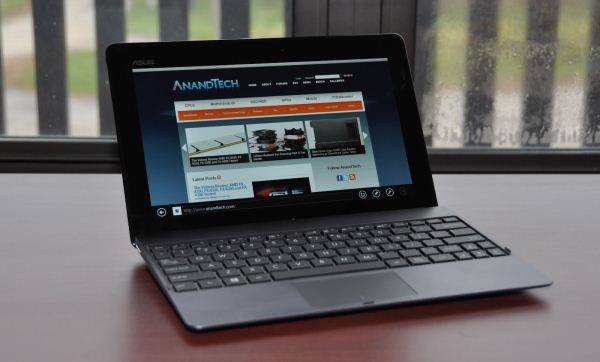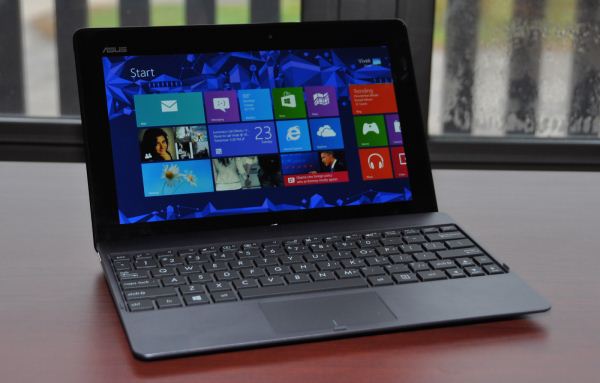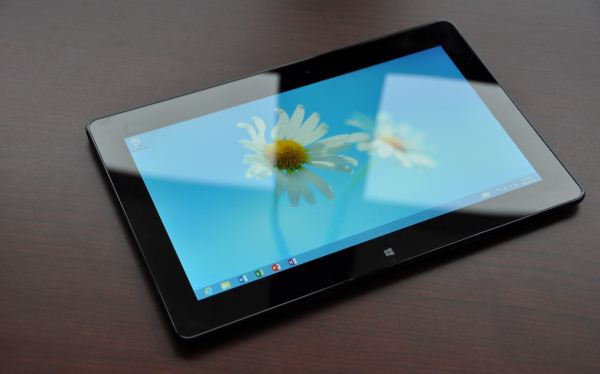ASUS VivoTab RT Review
by Vivek Gowri on October 23, 2012 3:01 PM EST- Posted in
- Asus
- Mobile
- Tablets
- Windows RT
- Vivo Tab
Windows RT is Microsoft’s big play for the tablet market. Our full Windows RT review will be posted later tonight, so for now I’m just going to share my personal impressions of the operating system from my time with the VivoTab RT.
This is a story that begins with Apple, who have spent a lot of time in the last two years talking about the “post-PC era”. Unfortunately, their product lines continue to be distinctly divided between mobile devices and personal computers. Going forward, that might change, but for now there’s just a significant gap between the iPad and the 11” MacBook Air. Microsoft has avoided that issue entirely by making the OS division happen between handhelds (phones) and portables (tablets and notebooks), instead of between tablets and notebooks. Given the similarity in size and usage between 10” tablets and the smallest notebooks, this makes a ton of sense to me. In Microsoft’s version, the post-PC world isn’t actually post-PC at all, it just involves the next evolution of the PC. Count me as a fan.
The VivoTab RT serves almost all of my purposes as a notebook replacement in ways I’ve spent 2.5 years wishing my iPad would. I’ve had all three iPads, all launch-day purchases. The first lasted exactly ten days before I returned it for general uselessness. I kept my iPad 2 for nine months, but spent about seven of them not using it at all. My 2012 iPad though has actually been a pretty valuable mobile companion to me - the screen is finally sharp enough for me to use it as an ebook reader, and as the device has gotten more powerful, it’s gotten easier to do a lot of my browsing and quick messaging/email/text editing on it. I’ve supplemented it at various times with different Bluetooth mobile keyboards (including Microsoft’s new W8-centric Wedge Mobile Keyboard), and turned it into a semi-credible facsimile of a notebook PC. But it never came together properly for me - it’s still too difficult to get real work done on an iPad. Not quite impossible anymore, but still not easy, or as easy as it should be.
Windows RT (and Windows 8) changes that for me. The tablet-centric Metro design language (now officially referred to as “Modern UI”, but it will always remain Metro in my heart) is obviously designed around the touchscreen input, and it’s entirely possible to avoid desktop mode if you want to, so it really works seamlessly as a tablet. This is the best task switching implementation I’ve seen yet for modern tablets, as well as the most thorough use of gestures. A few of them are a little intricate at first, like tile reorganization, but quickly become second nature. We’ve long been fans of the Windows Phone 7 user interface, regardless of the platforms other flaws, and seeing it expanded to tablets is great.
Windows RT and Windows 8 look and feel exactly the same. There are three major differences that are worth talking about. The first is Office 2013 being included for free - I frequently take this for granted, because I’ve always gotten Office free from school, work, or friendship with a large number of Microsoft employees (a hazard of being an Indian living in the Seattle area) - but if you don’t get Office for free, it’s a nice throw-in that certainly adds to some of the cost of the platform. And when you think about it, $499 for a Windows RT tablet with 32GB of NAND and Office 2013 included free out of the box is actually a pretty good deal compared to the $499 16GB iPad.
The others are x86-related - you obviously give up a ton amount of compute horsepower versus any of the Core-based processor, but even compared to Clover Trail, Tegra 3 is not that fast. Well matched to the platform though, and other than some issues with application load times (becoming a common theme with Microsoft OSes, it appears) you rarely feel the lack of speed when you stay in Metro/Modern UI. Entering Windows Desktop mode brings up some noticeable lag though, particularly in closing IE (desktop) tabs and other windows. Sure, I’m used to i7/SSD machines in my daily life, but these are the kinds of lags that you rarely find on, say, ultrabooks. And when you look at CPU utilization, you’re in for a bit of a shocker. Using the keyboard dock, you can get to 30% CPU load in Word 2013 when just typing (like a madman, sure, but still). Switch to the virtual keyboard and press buttons at random? You can get to 50% load, easy. When typing normally, you can get to 25-30% without trying too hard. With any A9-based SoC, you can’t expect the greatest performance, but it does give me a lot of hope for the Krait and Clover Trail-based tablets set to come out, not to mention A15 next year.
The single biggest difference though, is the lack of x86 app compatibility. This seems like an obvious difference at first - duh, it’s ARM, of course x86 applications don’t work - but it’s something that you can almost forget as you start using Windows desktop mode. For applications, you’re limited to the Windows Store, which serves up apps that are built to run within Modern UI and are designed around the Metro aesthetic. The selection at the moment is a little bit lacking, but we’re still three days from the official launch of Windows 8/RT, so I’m not going to judge it yet. This is Windows we’re talking about, so I’m not terribly worried about the development of the app library - it’ll happen soon, or Microsoft will pay developers to make it happen soon. Either way, we should see a much healthier selection of apps in the near future.
One side effect of this is that, unless I’m writing, I don’t enjoy using the keyboard dock very much - mouse inputs just aren’t as convenient as touching the screen and getting to where you want, particularly since certain mouse gestures within Modern UI just aren’t that intuitive. It’s a brilliant touch UI, just not a brilliant desktop one. (Side note: in Windows 8, particularly for normal notebook and desktop users, this is an entirely overblown issue - you can basically treat Modern UI as a fancy Start menu, and spend the rest of your life in Windows desktop. It works exactly the same way - hit the Windows key, start typing to search through applications, and if you do it right, that can be the vast majority of your interaction with the Metro-side of things. Yes, I agree that Metro is far and away not a great UI to navigate with a mouse, but people who claim that Windows 8 will ruin their desktops just sound uninformed. But I digress.)
I’ve still kept the VivoTab RT docked for a majority of the time though, for two reasons. One - after a year and a half with the iPad Smart Cover, I’ve gotten used to having a way to stand my tablet up (I love that Surface has this built in.) The other is the battery life thing, which I’ll get to in a bit, but having a combined total of 47Wh of battery capacity in a Windows system is just awesome.
And that’s what’s important to remember with Windows RT - beneath Modern UI, it’s still just Windows. Same file structure, same control panel, same task manager. If you don’t want to use it, you almost never have to see it - there’s very few workflows that require desktop mode to be used (Office 2013, which runs in the desktop, can be fullscreened to block the rest of Windows out). But if you want the control and power that you typically get in a normal PC, it’s all still here for you. It’s incredibly reassuring - this works just like every computer I’ve owned since my first Gateway 2000 back in 1996, at the tender age of 5. It’s just Windows, except with a touch-screen UI on top of it.
I’m coming away from this review feeling very positive about Windows RT, much more so than I expected. After a few days with it, I’m officially done with my iPad. Like, that’s it, we had a good run, it’s over. (In related news, if anyone wants a pristine condition 3rd generation iPad, my email address is linked to the byline. I’m only halfway joking.) Windows RT hits the convergence for me better than any previous tablet and integrates into my workflow almost seamlessly, making it the first tablet platform that seriously has a shot at replacing my notebook.














68 Comments
View All Comments
AahzNotOz - Tuesday, October 23, 2012 - link
One thing I haven't seen discussed about RT is will it play the Windows extracted Digital Copy movies you sometimes get with Blu-Ray? I know Win 8 Pro slates should be able to play them fine, but how about Win RT?KineticHummus - Tuesday, October 23, 2012 - link
Hopefully this thing can play back high profile H264 like what most people use for MKV's! I'd love to be able to take some 720p anime on the bus with me. None of the 10 inch android tablets are too interesting to me, and the nexus 7 is too small. The iPad is out of the question, it cant play my files.Urizane - Tuesday, October 23, 2012 - link
High profile H.264 in an MP4 container on an iPad...sure. I'm guessing you're just not thrilled about burning in subtitles. As far as Windows RT goes...I'm guessing MKV support is going to have to come by way of a "Modern UI" (Metro) app playing MKVs back in software (slow) rather than through the hardware accelerator. I only say that, because messing with the core components (e.g. adding a DirectShow filter) is probably not allowed out of the box, and any .AX file would have to be compiled for Windows on an ARM CPU anyway. In such a case, you're still better off with H.264 in an MP4 container, because that's guaranteed to work. The same tricks used on Windows 7 for hardware playback of MKV streams should still work in Windows 8 Pro. You might need to lean in that direction if you have a complete aversion to demuxing your MKVs and muxing them into MP4s.frozentundra123456 - Tuesday, October 23, 2012 - link
Sorry, but I guess I am not that familiar with Win RT. What can you really do on Win RT? I mean if it doesnt run x86 apps, does it run android apps, or just apps from the microsoft store?It seems like kind of in limbo to me. TBH, I really hate Android. Hundred, thousands, whatever of apps, but I have yet to find any that are useful and work well. The few useful apps that I have tried tend to have some fatal flaw such as being frustratingly slow, locking up. crashing, etc.
So if you cant run x86 apps, how is this an improvement?
Roland00Address - Wednesday, October 24, 2012 - link
When Windows RT launches there is going to be about 3000 apps in the Microsoft store.This will change with time, remember if an app is developed for the Microsoft store it will work on windows rt or windows 8 regardless of the processor in use.
Windows 7 phones launched with about 2,000 apps, it had 20,000 apps 6 months later, 40,000 apps 12 months later, and now has over a 100,000 apps.
You are going to see a similar or faster app development for windows 8 for the fact more people are going to use windows 8 then you are going to see people using windows 7 phone.
horibatech - Tuesday, October 23, 2012 - link
I dont know if it just because I have heard you talk on the podcast, but I love the 'tone' if your review. All the Anandech respectability with some Vivek flair. It's up to you, Anand, and the comments section, but I for one appreciate your candor and actually putting you opinion on the line. Keep up the good work and stay on the podcast!Death666Angel - Friday, October 26, 2012 - link
I think I'll wait until 2013 with new ARM and Intel architectures. Just feels like it is "too early" for IVB/CortexA9 Win8/RT. Haswell and A15 should do much to help with performance/battery life.BlueInAtlanta - Monday, December 31, 2012 - link
This device is the opposite of sleek. There's just too much machine around the edges and looks outdated. Still, I use it to sketch design ideas for my graphic design firm here in San Francisco. The tablet's nice display and its compatibility with AT&T's 4G LTE make it a very competitive model despite the looks.